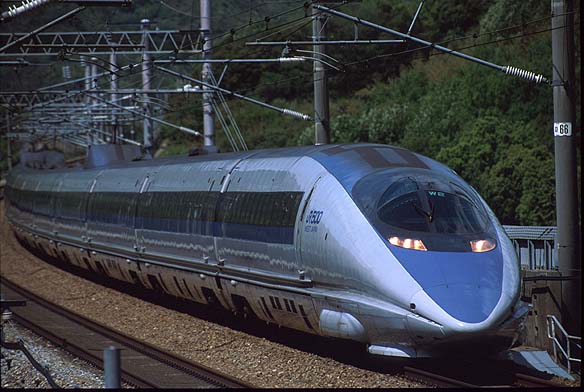In order to raise the speed of Shinkansen services, JR West had introduced
230km/h operation by 100 series, or 270km/h by 300 series. In 1996, JR
West developed 500 series based on the technologies delivered by WIN350,
making this the fastest service train in Japan.
Compared with 300 series, all the axles on the train are powered with ac
traction motors rated at 275 kW each to realize 300km/h operation. Traction
motors are controlled by VVVF inverter traction system. The regenerative
braking system is incorporated.
500 series adopt bolsterless bogies, the journal box supporting system of which is axle arm type. The yaw dampers and semi-active suspension system are employed to ensure smooth ride characteristics even at 300km/h. Anti-yaw dampers are also fitted between cars for improved stability.
The current collectors feature 2 aerodynamic "T" type current
collectors developed on WIN350. 500 series adopts brazed aluminum honeycomb
body construction to achieve light body, silent cabin and body stiffness.
The 15m long nose sections are employed to reduce the noise from them.
The shape of cross section of its body is circular considering the wind
pressure while the trains pass each other in the tunnel.
Passenger accommodation is in the standard layout of 2+2 seating in first
class, and 2+3 in standard class. Standard class seat pitch is reduced
to 1020 mm compared with 1040 mm on the 300 series to maintain the same
overall seating capacity. Although refreshment counters were located in
cars 7 and 11, they were discontinued later.
After a total of 9 sets were delivered, production of high-cost 500 series was discontinued and 700 series have been delivered instead of them.
Although the 500 series sets were initially employed exclusively on the
premior Tokyo to Hakata Nozomi services operated at 300km/h, they have
gradually been displaced by later N700 series from 2007. The last remaining
JR West Nozomi services using 500 seriesstock between Tokuo and Hakata
were switched to N700 series trains from 2010. |
|
| Technical Data |
| Items |
Data |
| Built |
1996-1998 |
| Construction |
Aluminum |
| Formation |
16M |
| Supply
voltage |
25,000VAC,
60Hz |
| Service
speed, etc. |
Acceleration:
1.96km/h/s Service speed:300km/h (Designed Max. Speed:
320km/h) |
| Length |
27,000mm
(End cars) 25,000mm (Intermediate cars) |
| Width |
3,380mm |
| Height |
3,690mm |
| Bogie |
WDT205
(motored) |
| Collector |
WPS204 Wing-shape
(2 per 16-car train) |
| Traction
motor |
WMT204
(275kW) |
| Gear ratio |
2.79 |
| Transformer |
TM |
| Controller |
WPC5 (GTO
thyristor) |
| Air conditioner |
WAU601 |
| Designed
by |
JR West |
|
|

